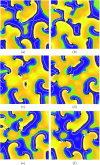Robust approach for rotor mapping in cardiac tissue
- PMID: 31154775
- PMCID: PMC6499622
- DOI: 10.1063/1.5086936
Robust approach for rotor mapping in cardiac tissue
Abstract
The motion of and interaction between phase singularities that lie at the centers of spiral waves capture many qualitative and, in some cases, quantitative features of complex dynamics in excitable systems. Being able to accurately reconstruct their position is thus quite important, even if the data are noisy and sparse, as in electrophysiology studies of cardiac arrhythmias, for instance. A recently proposed global topological approach [Marcotte and Grigoriev, Chaos 27, 093936 (2017)] promises to meaningfully improve the quality of the reconstruction compared with traditional, local approaches. Indeed, we found that this approach is capable of handling noise levels exceeding the range of the signal with minimal loss of accuracy. Moreover, it also works successfully with data sampled on sparse grids with spacing comparable to the mean separation between the phase singularities for complex patterns featuring multiple interacting spiral waves.
Figures








References
-
- Sandstede B., Scheel A., and Wulff C., “Dynamics of spiral waves on unbounded domains using center-manifold reductions,” J. Differ. Equ. 141, 122–149 (1997). 10.1006/jdeq.1997.3326 - DOI
-
- Biktashev V. N. and Holden A. V., “Resonant drift of autowave vortices in two dimensions and the effects of boundaries and inhomogeneities,” Chaos Solitons Fractals 5, 575–622 (1995). 10.1016/0960-0779(93)E0044-C - DOI
-
- Biktashev V. N., Holden A. V., and Nikolaev E. V., “Spiral wave meander and symmetry of the plane,” Int. J. Bifurcat. Chaos 6, 2433–2440 (1996). 10.1142/S0218127496001582 - DOI
-
- Fiedler B., Sandstede B., Scheel A., and Wulff C., “Bifurcation from relative equilibria of noncompact group actions: Skew products, meanders, and drifts,” Doc. Math. 141, 479–505 (1996).
MeSH terms
Grants and funding
LinkOut - more resources
Full Text Sources
Medical

